Vitamin D
- Way of life that does not become an illness 病気にならない生き方
すべての原因による死亡に対するビタミンD補充の効果
Effects of vitamin D supplementation on all cause mortality
ビタミンDと原因別死亡リスク
系統的レビューと観察コホートとランダム化された介入研究のメタアナリシス
Vitamin D and risk of cause specific death: systematic review and meta-analysis of observational cohort and randomised intervention studies
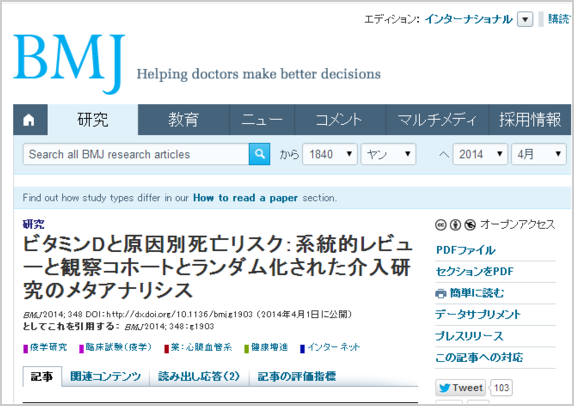
© 2014 BMJ Publishing Group Ltd
はじめに / Introduction
ビタミンDは、カルシウムおよびビタミンD 2つの主要な形態が存在するphosphate.1の腸管吸収に関与する脂溶性ビタミンの基である。植物に見られるビタミンD2(エルゴカルシフェロール)は、エルゴステロールの紫外線B照射により生成され、他方では、ビタミンD3(コレカルシフェロール) 、 7の紫外線B照射の生成物又はサプリメントとして要塞foods.2で消費することができる - デヒドロコレステロールは、ヒト表皮で合成し、または天然(例えば、魚)または強化食品源の形で、またはビタミンDとsupplement.2の補給は、くる病、骨折などの骨格条件に利益をもたらすことが示されているように消費され、転倒、 3 4 5骨密度に対する同様の効果が多くの証拠をtrials.6の最近のレビューで明らかではなかったが、ビタミンDは、多発性硬化症、自己免疫疾患、感染症を含む広範囲の疾患のリスクを低減できることを示している、および心血管代謝と癌の結果、 7 8骨外のシステム間での可能な多面的な効果を示す9 10 11 12 。しかしながら、非骨格疾患のリスクを低減するビタミンDの証拠はまだdebated.13されている
Vitamin D is a group of fat soluble vitamins responsible for intestinal absorption of calcium and phosphate.1 Two major forms of vitamin D exist. Vitamin D2 (ergocalciferol), found in plants, is produced by ultraviolet B irradiation of ergosterol and can be consumed as a supplement or in fortified foods.2 Vitamin D3 (cholecalciferol), on the other hand, a product of ultraviolet B irradiation of 7-dehydrocholesterol, is synthesised in the human epidermis or consumed in the form of natural (for example, fish) or fortified food sources or as a supplement.2 Supplementation with vitamin D has been shown to benefit skeletal conditions such as rickets, fractures, and falls,3 4 5 although a similar effect on bone mineral density was not evident in a recent review of trials.6 A growing body of evidence indicates that vitamin D may reduce risks of a wide range of diseases including multiple sclerosis, autoimmune disorders, infections, and cardiometabolic and cancer outcomes,7 8 9 10 11 12 indicating a possible pleiotropic effect across extraskeletal systems. However, the evidence for vitamin D reducing the risk of non-skeletal diseases is still being debated.13
ビタミンDの準最適濃度も、その幅広い抗炎症作用と免疫調節effects.2 14 15しかし、この魅力的なリンクを調べる可能な観察研究が厳密に見直しがまだあり、ある程度の死亡率の潜在的な決定因子として関与しているこれにビタミンD欠乏、心血管疾患、癌、または他の条件による死亡のリスクを与えることは不確かなままである。いくつかの個々のレポートやレビューは、トピック上で公開されているが、 16 17 18 19 20 21彼らは大きく異なると十分な詳細を欠いている(例えば、死亡または二次予防の設定に対する原発の多様な原因のための団体) 。
Suboptimal concentrations of vitamin D have also been implicated as a potential determinant of mortality because of its wide ranging anti-inflammatory and immune modulating effects.2 14 15 However, available observational studies examining this intriguing link are yet to be rigorously reviewed, and the extent to which vitamin D deficiency confers risk of death from cardiovascular disease, cancer, or other conditions remains uncertain. Although several individual reports and reviews have been published on the topic,16 17 18 19 20 21 they vary greatly and lack sufficient detail (for example, associations for diverse causes of death or primary versus secondary prevention settings).
彼らは一般的に(心血管risk22に関連付けられているカルシウム摂取と組み合わせるなど)混合介入を用いた研究が含まれており、全体に影響を区別するための詳細な評価を欠いているように加えて、ランダム化試験の以前の定量的なレビューの解釈は、 18 21 、困難である(このような地理的位置、介入線量と期間、およびフォローアップ時間など)の重要な特性。
Additionally, interpretation of the earlier quantitative reviews of randomised trials is difficult,18 21 as they typically include studies with mixed interventions (for example, combined with calcium intake, which has been associated with cardiovascular risk22) and lack detailed assessments to distinguish the effects across important characteristics (such as geographical location, intervention dosage and duration, and follow-up time).
必要性は、一次および二次予防の設定を横切り、原因の広い範囲からの死亡リスクとビタミンD濃度の関連を十分に搭載、総合的に評価するために、したがって、存在しています。死亡リスクの推定値は、予防または早期死亡を減少させ、生活の質を改善するために保健政策の処方において礎石のままであり、この意味では、ビタミンDが重要な役割を果たしている可能性があるので、これは特に重要である。
A need exists, therefore, for an adequately powered, comprehensive assessment of associations of vitamin D concentrations with the risk of mortality across primary and secondary prevention settings and from a broad range of causes. This is of particular importance because estimates of mortality risk remain a cornerstone in formulating health policies to prevent or reduce premature deaths and improve quality of life, and in this sense vitamin D might play a key role.
本研究では、 ( a)は観察コホート研究で、原因別死亡率の結果のリスクと25 - ヒドロキシビタミン濃度の関連性を判断するために1に更新系統的レビューとメタ分析で利用可能な観察とインターベンショナルな証拠を要約することを目的としています。 ( b)は、ビタミンD補充(全体およびサブタイプによる)の影響を定量化、ランダム化比較試験における死亡率の結果にプラセボまたは無治療と比較して、単独で与えられたとき;および( C )の研究レベル特性の広い範囲の下ですべての関連を調べる。
In this study, we have aimed to summarise the available observational and interventional evidence in one updated systematic review and meta-analysis to (a) determine the associations of 25-hydroxyvitamin concentrations with the risk of cause specific mortality outcomes in observational cohort studies; (b) quantify the effects of vitamin D supplementation (overall and by subtypes), when given alone compared with placebo or no treatment, on mortality outcomes in the randomised controlled trials; and (c) examine all associations under a wide range of study level characteristics.
方法 / Methods
データソース、検索戦略、および適格基準
私たちは、事前に定義されたプロトコルにとPRISMAとMOOSEガイドライン( eAppendix 1及び2 ) 0.23 24二つの独立した著者によると、重複で、 MEDLINE、 EMBASEを用いて、 (日付は最後に検索) 2013年8月1日の前に発表された研究を求めに従って、このレビューをしました、およびコクランデータベース。コンピュータベースの検索は、
Data sources, search strategy, and eligibility criteria
We did this review according to a predefined protocol and in accordance with the PRISMA and MOOSE guidelines (eAppendix 1 and 2).23 24 Two independent authors, in duplication, sought studies published before 1 August 2013 (date last searched) using Medline, Embase, and Cochrane databases. The computer based searches combined terms related to the exposure (such as vitamin D, 25-hydroxyvitamin D) and outcomes (such as mortality,
任意の言語の制限なく(例えば、ビタミンDと、 25 - ヒドロキシビタミンD )の曝露と(例えば、死亡率は、すべての原因による死亡、死亡など)の結果に関連する用語を組み合わせる。検索方法の詳細はeAppendix 3で提供されています。我々は、すべての原因による死亡(あらゆる原因による死亡と定義される)とビタミンD ( 25 - ヒドロキシビタミンDとして測定される) 、またはビタミンDのサプリメントを循環させるか、特定の原因の関連付けに報告していた研究を追求死亡(心血管疾患、癌、および他の原因による死亡と定義される) 、ここで致命的な成果は、国際分類からコーディングに基づいて、 (それが存在しない、根本的な原因で、または)主な原因に応じて登録されていた疾患または定義された分類と研究によると、確認は、死亡診断書に基づいていた。
all cause mortality, death), without any language restriction. Details of the search strategy are provided in eAppendix 3. We sought studies that had reported on associations of circulating vitamin D (measured as 25-hydroxyvitamin D) or vitamin D supplements with all cause mortality (defined as deaths from any causes) or cause specific mortality (defined as deaths due to cardiovascular disease, cancer, and other causes), in which fatal outcomes were registered according to the primary cause (or, in its absence, the underlying cause), on the basis of coding from the international classification of diseases or according to study defined classifications; ascertainment was based on death certificates.
研究の選択 / Study selection
彼らは特定の原因、大人の中のすべての原因による死亡と25 - ヒドロキシビタミンD濃度の循環の関連を評価し、次のカテゴリのいずれかからの参加者を募集している場合観察コホート研究では、含めることに適格であった。一般集団、つまり、参加者はベースで選択されていない心臓血管、代謝性、悪性、または腎障害(すなわち、一次予防コホートである)を含む既存の慢性疾患の;または(つまり、二次予防コホートである) 、上記の既存のベースラインの状態を持つ人々 。
Observational cohort studies were eligible for inclusion if they assessed association of circulating 25-hydroxyvitamin D concentration with cause specific or all cause deaths in adults, and recruited participants from either of the following categories: general populations—that is, participants not selected on the basis of pre-existing chronic disease, including cardiovascular, metabolic, malignant, or renal disorders (that is, primary prevention cohorts); or people with pre-existing baseline conditions mentioned above (that is, secondary prevention cohorts).
彼らがランダム化された場合は、介入研究は適格とした。ビタミンDサプリメントの査定の効果は単独でプラセボまたは無治療と比較して、成人で(つまり、 「ビタミンDだけでは「介入群とのランダム化比較試験である) ; (先に定義したように) 、特定またはすべての原因による死亡のエンド原因収集。二つの独立したレビューアが選択基準に従って、すべての最初に同定された研究のタイトルと抄録をスクリーニングするために一緒に働いた。フルテキストはすべての選択基準を満たした研究のために回収した。私たちは、選択した研究やその他の資料のためのトピックの関連の系統的レビューの参考文献リストを検索しました。
Intervention studies were eligible if they were randomised; assessed effects of vitamin D supplements singly (that is, randomised controlled trials with a “vitamin D alone” intervention group) in adults compared with a placebo or no treatment; and collected cause specific or all cause mortality endpoints (as defined before). Two independent reviewers worked together to screen the titles and abstracts of all initially identified studies according to the selection criteria. Full texts were retrieved for studies that satisfied all selection criteria. We searched reference lists of selected studies and relevant systematic reviews on the topic for additional publications.
データ抽出 / Data extraction
二つの独立した著者は、データを抽出し、コンセンサスは、第三の関与で到達した。我々は、関連情報を抽出するためにデザイン済みデータ抽象化形式を用いる。相対リスクは、年齢、性別などの確立された心血管リスク因子について調整したとき、これは研究のサイズ、研究デザイン、ベースラインの人口、場所、ベースライン時の年齢、フォローアップの期間中、 「+」と定義され、調整の報告された程度(上の質問が含まれてい、喫煙状況、脂質、高血圧、心血管代謝疾患の病歴、 「+ + 」などの身体活動、体格指数、社会的地位など、他の潜在的な危険因子について調整時に、追加的に、他の追加の変数を調整したときに「+ + +」など骨ミネラルなど)、タイプと死亡成果の番号、相対リスクを報告した。
Two independent authors extracted data, and a consensus was reached with involvement of a third. We used a predesigned data abstraction form to extract relevant information. This included questions on study size, study design, baseline population, location, age at baseline, duration of follow-up, reported degree of adjustment (defined as “+” when relative risks were adjusted for established cardiovascular risk factors such as age, sex, smoking status, lipids, hypertension, history of cardiometabolic disease; “++” when adjusted for other potential risk factors such as physical activity, body mass index, social status; and “+++” when additionally adjusted for other additional variables such as bone minerals), type and numbers of mortality outcomes, and reported relative risks.
適切な場合、我々は、ビタミンDサプリメント、栄養補助食品及び対照群の参加者数、ベースラインの循環ビタミンD濃度は、アッセイ方法、目詰まり状態、およびサプリメントまたはプラセボの組成物のサブタイプについての情報を抽出した。リスク推定値が発表したレポートから利用できなかった場合は、他の公開レビュー、 19 21 28または手紙から入手可能な情報、 29 30 31に基づいて計算することから抽象作家、 25 26 27に対応することで、関連するデータを収集した場合、該当する。さらに、複数の出版物のケースでは、日付や包括的なinformation.32 33までのほとんどが含まれてい
Where appropriate, we extracted information on subtypes of vitamin D supplement, number of participants in the supplement and control groups, baseline circulating vitamin D concentration, assay method, blinding status, and composition of supplement or placebo. If risk estimates were unavailable from a published report, we collected relevant data by corresponding with the authors,25 26 27 abstracting from other published reviews,19 21 28 or hand calculating on the basis of the available information from the paper,29 30 31 where appropriate. Additionally, in the case of multiple publications, we included the most up to date or comprehensive information.32 33
バイアスのリスクの評価 / Assessment of risk of bias
参加者の選定、研究グループの比較:観察コホート研究のために、私たちは、このスケールは3ドメインでの研究を評価するために( 9つ星の最大値を有する)星系を使用していますbias.34のリスクを評価するためにニューカッスル·オタワスケールを使用、および目的の成果の把握。
For observational cohort studies, we used the Newcastle-Ottawa Scale to assess the risk of bias.34 This scale uses a star system (with a maximum of nine stars) to evaluate a study in three domains: selection of participants, comparability of study groups, and the ascertainment of outcomes of interest.
我々は、バイアス、中程度のリスクがあると7または8つ星を獲得した研究、およびバイアスのリスクが高いと6以下を記録したものの低リスクがあると9つ星のスコアを受け取った研究を判断した。 、アウトカム評価の盲検化、参加者や関係者の盲検化、ランダムシーケンスの生成、割り付けの隠蔽不完全な結果を:同様に、ランダム化試験のために、我々は、このツールは、バイアスの7可能なソースを評価bias.35のリスクを評価するためのコクラン共同計画のツールを使用データ、選択的なレポート、およびその他のバイアス。個々のドメインのために、我々はバイアスの低い不明瞭、および高リスクに研究を分類した。
We judged studies that received a score of nine stars to be at low risk of bias, studies that scored seven or eight stars to be at medium risk, and those that scored six or less to be at high risk of bias. Similarly, for the randomised trials, we used the Cochrane Collaboration’s tool for assessing the risk of bias.35 This tool evaluates seven possible sources of bias: random sequence generation, allocation concealment, blinding of participants and personnel, blinding of outcome assessment, incomplete outcome data, selective reporting, and other bias. For each individual domain, we classified studies into low, unclear, and high risk of bias.
データ合成と分析 / Data synthesis and analysis
このレビューでメタ分析および調査結果の解釈に一貫性のあるアプローチを可能にするために、我々は、 25 - ヒドロキシビタミンDと死亡の結果、多くの場合、別々にそれぞれの観察コホート研究によって報告された36の循環関連付けのために、相対リスク推定値を変換するために以前に記載された方法を使用一貫して25 - ヒドロキシビタミンD濃度のベースライン分布の上位3分のに対して下部の比較に対応して、 (例えば、 1標準偏差の変化当たり、単位変化当たり、あるいは五分の、四半期、 3分と他のグループを比較する)各研究。簡単に言えば、我々は極端な分が1標準偏差増加を2.18倍ログリスク比と同等であるとの比較で、正規分布を仮定して、ログ·リスク比を変えて(または同等に、極端の比較のため2.18/2.54倍対数リスク比として四半期) 。
To enable a consistent approach to meta-analysis and interpretation of findings in this review, we used previously described methods to transform relative risk estimates for association of circulating 25-hydroxyvitamin D and mortality outcomes,36 which were often differently reported by each observational cohort study (for example, per unit change, per one standard deviation change, or comparing fifths, quarters, thirds, and other groupings), to consistently correspond to comparison of the bottom versus the top third of the baseline distribution of 25-hydroxyvitamin D concentrations in each study. Briefly, we transformed log risk ratios by assuming a normal distribution, with the comparison between extreme thirds being equivalent to 2.18 times the log risk ratio for one standard deviation increase (or equivalently as 2.18/2.54 times the log risk ratio for a comparison of extreme quarters).
当社は、公開された信頼限界を使用してログのリスク比の標準誤差を計算し、同じ方法でそれらを標準化しました。私たちは、リスク比と同じ尺度を近似するハザード比とオッズ比を仮定した。我々は、研究の不均一性(および追加的に固定効果モデルを用いて)との間に含まれたランダム効果モデルを用いて検討特定のリスク比を合わせた。
We calculated standard errors of the log risk ratios by using published confidence limits and standardised them in the same way. We assumed hazard ratios and odds ratios to approximate the same measure of risk ratios. We combined study specific risk ratios by using a random effects model that included between study heterogeneity (and additionally using fixed effect models).
研究は調整の様々な程度でリスク比を報告したところ、我々は最大限に調整見積りを使用していました。我々は( 21〜29 、 10から20と定義し、
Where studies reported risk ratios with varying degrees of adjustments, we used the maximally adjusted estimate. We based subsidiary assessments involving circulating 25-hydroxyvitamin D cut-offs (defined as 21-29, 10-20, and
これらは(ビタミンD3およびD2サブタイプのサプリメントによる個別)全体のビタミンD補充のため、利用できなかった場合は、無作為化介入試験のために我々は使用されるイベント発生率に基づいて調整されたリスク比、または計算された研究で、特定の未調整リスク比を報告した。
For randomised intervention trials we used reported adjusted risk ratios, or calculated study specific unadjusted risk ratios based on event rates if these were unavailable, for overall vitamin D supplementation (and individually by supplements of vitamins D3 and D2 subtypes). We calculated summary risk ratios by pooling the study specific estimates with a random effects model that included between study heterogeneity (parallel analyses used fixed effect models).
我々は、研究異質(パラレル分析は固定効果モデルを使用)との間に含まれるランダム効果モデルを用いた研究の特定の推定値をプールすることにより、要約リスク比を算出した。我々はレベルの特性を研究するために応じてグループ分けの研究の結果を比較することにより、不均一性を定量化するために、メタ回帰ランダム効果を使用される標準的なχ2検定とI2のstatistic.41と研究間で結果の一貫性を評価した。さらに、当社は、単変量メタ回帰は、日々の介入のサプリメントと介入の期間の投与量や補充裁判と観察コホート研究の両方のための効果の推定値の大きさのフォローアップとして、研究レベルの特性の影響を調べるために分析しました。
We assessed consistency of findings across studies with standard χ2 tests and the I2 statistic.41 We used random effects meta-regression to quantify heterogeneity by comparing results from studies grouped according to study level characteristics. Additionally, we did univariate meta-regression analyses to investigate the effect of study level characteristics such as daily intervention dose of supplement and duration of intervention or follow-up on the size of the effect estimates for both supplementation trials and observational cohort studies.
我々は従属変数と説明要因としての学問レベル特性としてリスク比の自然対数を使用していました。私たちは、漏斗プロットし、我々は次の式で、人口寄与危険度を算出したエッガーのtest.42を使って、出版バイアスの証拠を評価した。のPAR % = 100 × PE( RR - 1 ) / (PE ( RR - 1 ) +1) 43ここでPeは露出( eAppendix 5 )の有病率である。すべての統計的検定は片側2だったとP
We used the natural logarithm of the risk ratio as the dependent variable and the study level characteristic as the explanatory factor. We assessed evidence of publication bias by using funnel plots and the Egger test.42 We calculated the population attributable risk with the following equation: PAR%=100×Pe(RR−1)/(Pe(RR–1)+1),43 where Pe is the prevalence of the exposure (eAppendix 5). All statistical tests were two sided and used a significance level of P
結果 / Results
検索方法は、 2704年のユニークな引用を同定した。タイトルと抄録に基づいて、初期スクリーニングの後、 320の記事はさらなる評価のために残っていた。これらの記事のうち、 225はeFigure 1に示す理由のために、その後の詳細な評価に除外された。残りの95のユニークな研究報告が私たちの選択基準に合致し、メタアナリシス( eAppendix 6 )に含まれていた。全体として、これらの含まれた研究は、 ( ; eTables 1-3 ⇓テーブル) (心血管疾患による10 777人が死亡し、がんによる死亡者6911を含む) 880 128ユニークな参加者と71 625死亡成果を含んでいた。
The search strategy identified 2704 unique citations. After initial screening based on titles and abstracts, 320 articles remained for further evaluation. Of these articles, 225 were excluded in the subsequent detailed assessments for reasons shown in eFigure 1. The remaining 95 unique study reports met our inclusion criteria and were included in the meta-analysis (eAppendix 6). In aggregate, these included studies comprised 880 128 unique participants and 71 625 mortality outcomes (including 10 777 deaths from cardiovascular disease and 6911 deaths from cancer) (table⇓; eTables 1-3).
このテーブルを表示します。
ビューPopupViewインライン
た研究の概要特性。特に明記しない限り、値は、試験(参加者数)の数である
View this table:
View PopupView Inline
Summary characteristics of included studies. Values are number of studies (number of participants) unless stated otherwise
原因別死亡率で25 - ヒドロキシビタミンD濃度の循環協会
Association of circulating 25-hydroxyvitamin D concentration with cause specific mortality
死のその後のリスクに関連して25 - ヒドロキシビタミンD濃度の循環が平均追跡0.3から29年までの間に記録された849 412の参加者と66 511死亡事象が関与、 73観察コホート研究で報告された(表を⇑ 、タブレ1 ) 。これらの観察コホート研究の、南米から北米、アジア·太平洋地域から8 、および1からのヨーロッパ、 26から38 、関係の参加者。すべての年齢の中央値は、参加者が63 (四分位範囲59-71 )歳であった含まれています。
Circulating 25-hydroxyvitamin D concentration in relation to subsequent risk of death was reported in 73 observational cohort studies, involving 849 412 participants and 66 511 mortality events recorded during an average follow-up ranging from 0.3 to 29 years (table⇑; eTable 1). Of these observational cohort studies, 38 involved participants from Europe, 26 from North America, 8 from the Asia-Pacific region, and 1 from South America. The median age of all included participants was 63 (interquartile range 59-71) years.
私たちは、中程度のリスクがあるとバイアス、 41の低リスクがあるとし、 24の研究はバイアスのリスクが高い(タブレ1 )にあるように8研究を判断した。メディア品質の研究の中で、すべての参加者の選択において潜在的バイアスを示した。これらの研究における25 - ヒドロキシビタミンDの中央値は、ベースライン濃度は、 (四分位範囲17.5から24.3 ) ng / mLで20.7だった。一次予防コホートでは、 25 - ヒドロキシビタミンD濃度を循環ベースラインの人口分布の上三分のに対するボトムの人々の比較でプールされたリスク比は、いくつかの潜在的な危険因子について調整
We judged eight studies to be at low risk of bias, 41 to be at medium risk, and 24 studies to be at high risk of bias (eTable 1). Of the medium quality studies, all showed a potential bias in the selection of participants. The median baseline concentration of 25-hydroxyvitamin D in these studies was 20.7 (interquartile range 17.5-24.3) ng/mL. For the primary prevention cohorts, pooled risk ratios in comparisons of people in the bottom versus top thirds of the population distribution of baseline circulating 25-hydroxyvitamin D concentration, adjusted for several potential risk factors,
( 95%信頼区間1.13から1.61 )のための心血管疾患による死亡のための( 6416イベント) 、 1.14 ( 1.01から1.29 ) ( 5003イベント) 、 1.30 ( 1.07から1.59 )による死亡のための他の非血管性、非1.35だった癌による死亡のすべての原因による死亡( 48 488イベント) (図1 ⇓とeFigure 2 )のための( 1444イベント) 、および1.35 ( 1.22から1.49 ) 。対応するプールされたリスク比は、二次予防コホートにおいて広く類似していた。 25 - ヒドロキシビタミンD濃度を循環させる様々なカットオフ値による追加の分析は、すべての原因による死亡と有意な逆相関を示した( P
were 1.35 (95% confidence interval 1.13 to 1.61) for death from cardiovascular disease (6416 events), 1.14 (1.01 to 1.29) for death from cancer (5003 events), 1.30 (1.07 to 1.59) for other non-vascular, non-cancer death (1444 events), and 1.35 (1.22 to 1.49) for all cause mortality (48 488 events) (fig 1⇓ and eFigure 2). The corresponding pooled risk ratios were broadly similar in the secondary prevention cohorts. Additional analyses by various cut-off values of circulating 25-hydroxyvitamin D concentration showed a significant inverse association with all cause mortality (P
Fig 1 Association of circulating 25-hydroxyvitamin D concentrations with cause specific mortality in observational cohort studies. *Pooled estimates are based on random effects meta-analysis. Using fixed effects models, for primary prevention cohorts, secondary prevention cohorts, and all cohorts, the estimates were 1.40 (1.32 to 1.47), 1.50 (1.35 to 1.66), and 1.42 (1.35 to 1.49) for cardiovascular deaths; 1.10 (1.02 to 1.17), 1.45 (1.28 to 1.65), and 1.16 (1.10 to 1.24) for cancer deaths; 1.28 (1.12 to 1.47), 1.38 (1.09 to 1.75), and 1.30 (1.16 to 1.47) for non-vascular, non-cancer deaths; and 1.45 (1.41 to 1.49), 1.49 (1.42 to 1.56), and 1.44 (1.40 to 1.47) for all cause deaths. Size of data marker is proportional to inverse of variance of relative risk; horizontal line represents 95% CI. Corresponding forest plots and I2 (95% CI) estimates are provided in supplementary material
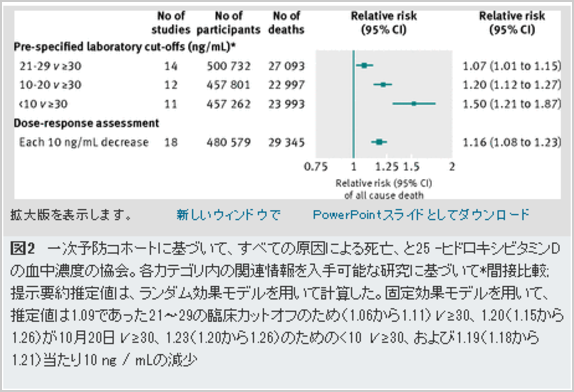
Fig 2 Association of circulating 25-hydroxyvitamin D concentrations with all cause mortality, based on primary prevention cohorts. *Indirect comparisons based on available studies with relevant information in each category; summary estimates presented were calculated using random effects models. Using fixed effects models, the estimates were 1.09 (1.06 to 1.11) for clinical cut-off of 21-29 v ≥30, 1.20 (1.15 to 1.26) for 10-20 v ≥30, 1.23 (1.20 to 1.26) for
子会社分析では、我々は、冠動脈疾患、リンパ腫、上部消化管癌、および呼吸器疾患( eFigure 3 )の死亡を含む様々な原因別死亡率の結果のために有意な逆の関連付けを発見した。我々は、部分的にしか様々なサブグループでの研究の違いの間で説明した観察研究で異質性の中程度のレベルを観察した(図3 ⇓ 、 4 ⇓ 、および5 ⇓ ) 。具体的には、
In subsidiary analyses, we found significant inverse associations for various cause specific mortality outcomes, including deaths due to coronary disease, lymphoma, upper digestive tract cancer, and respiratory diseases (eFigure 3). We observed a moderate level of heterogeneity in observational studies, which was only partially explained by between study differences in various subgroups (figures 3⇓, 4⇓, and 5⇓). Specifically,
図面3 ⇓ 、 4 ⇓ 、及び、 25 - ヒドロキシビタミンD濃度を循環させる低いベースラインのすべての死亡の結果のリスクは、集団の10%未満のビタミンDサプリメント(メタ回帰のP
the risk of all mortality outcomes for low baseline circulating 25-hydroxyvitamin D concentration was significantly higher in studies in which less than 10% of the population used vitamin D supplements (P for meta-regression
観察された全体的な関連性は、しかし、そのような研究の場所、性別、研究の質、季節性や社会経済的地位のための多変量調整、アッセイ法、調整のレベル、および地理的な位置(図3 ⇓ 、 4 ⇓の緯度などの他のサブグループ間で類似していたそして5 ⇓とeFigure 4 ) 。子会社単変量メタ回帰の結果の分析は、心血管疾患、癌による死亡、他の非血管、がん以外の死亡、およびすべての原因による死亡( P> 0.05による死亡のリスクとのフォローアップの期間の関連の証拠を示さなかったすべてのために) ( eFigure 5 ) 。
The overall associations observed, however, were similar across other subgroups such as latitude of study location, sex, study quality, levels of multivariate adjustment, assay methods, adjustments for seasonality or socioeconomic status, and geographical location (figures 3⇓, 4⇓, and 5⇓ and eFigure 4). Results from subsidiary univariate meta-regression analyses showed no evidence of associations of the duration of follow-up with risk of death from cardiovascular disease, death from cancer, other non-vascular, non-cancer death, and all cause mortality (P>0.05 for all) (eFigure 5).
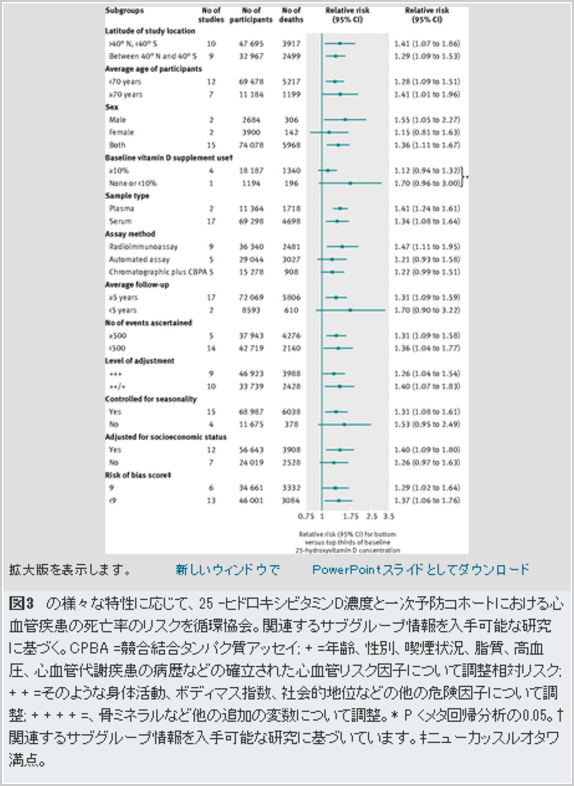
Fig 3 Association of circulating 25-hydroxyvitamin D concentration and risk of cardiovascular disease mortality in primary prevention cohorts, according to various characteristics. Based on available studies with relevant subgroup information. CPBA=competitive binding protein assay; +=relative risks adjusted for established cardiovascular risk factors such as age, sex, smoking status, lipids, hypertension, history of cardiometabolic disease; ++=adjusted for other potential risk factors such as physical activity, body mass index, social status; +++=adjusted for other additional variables such as bone minerals. *P
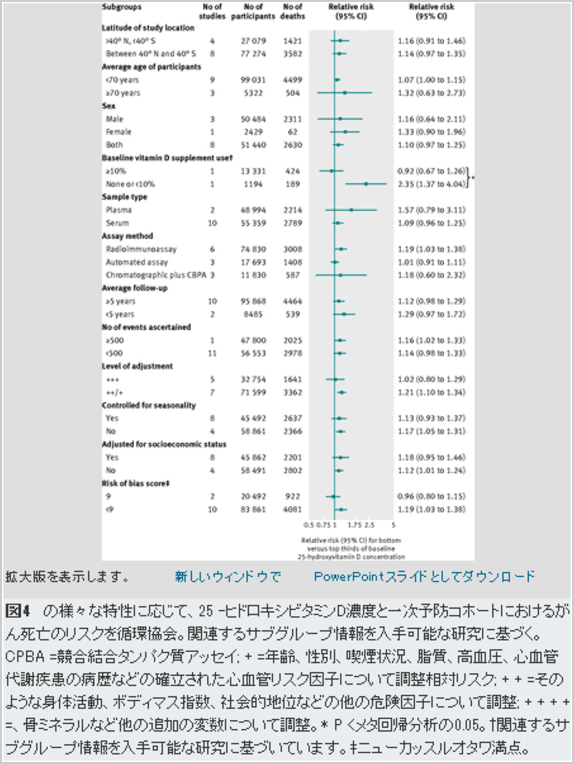
Fig 4 Association of circulating 25-hydroxyvitamin D concentration and risk of cancer mortality in primary prevention cohorts, according to various characteristics. Based on available studies with relevant subgroup information. CPBA=competitive binding protein assay; +=relative risks adjusted for established cardiovascular risk factors such as age, sex, smoking status, lipids, hypertension, history of cardiometabolic disease; ++=adjusted for other potential risk factors such as physical activity, body mass index, social status; +++=adjusted for other additional variables such as bone minerals. *P
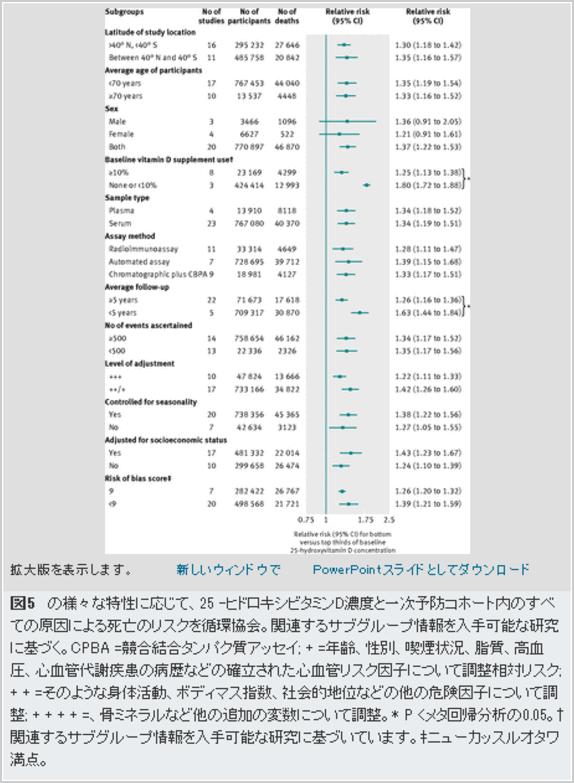
Fig 5 Association of circulating 25-hydroxyvitamin D concentration and risk of all cause mortality in primary prevention cohorts, according to various characteristics. Based on available studies with relevant subgroup information. CPBA=competitive binding protein assay; +=relative risks adjusted for established cardiovascular risk factors such as age, sex, smoking status, lipids, hypertension, history of cardiometabolic disease; ++=adjusted for other potential risk factors such as physical activity, body mass index, social status; +++=adjusted for other additional variables such as bone minerals. *P
すべての原因による死亡に対するビタミンD補充の効果
Effects of vitamin D supplementation on all cause mortality
二十2のランダム化比較試験を組み合わせサプリメント群と対照群での30 716の参加者の合計を含め、死亡率の結果、上の単独でのビタミンD補充の効果を報告している(表⇑ 、タブレ3 ) 。これらの試験の14は、ビタミンD3の効果を評価し、ビタミンD2の8報告された効果。
Twenty two randomised controlled trials reported effects of vitamin D supplementation in isolation on mortality outcomes, including a total of 30 716 participants in the supplement and control groups combined (table⇑; eTable 3). Fourteen of these trials assessed the effect of vitamin D3, and eight reported effects of vitamin D2.
サーティーン試験は、ヨーロッパからの参加者、北米から5 、およびアジア太平洋地域からの4を含んだ。これらの試験に含まれている参加者の平均年齢は56から85歳の範囲であった。セブンイレブン試験は、コミュニティベースのレジスタからの参加者(一般住民からの6とケアや住宅の家から5 )が含まれ、残りは臨床レジスタからの参加者を募集した。
Thirteen trials involved participants from Europe, five from North America, and four from the Asia-Pacific region. The average age of participants included in these trials ranged from 56 to 85 years. Eleven trials included participants from community based registers (six from the general population and five from care or residential homes), and the rest recruited participants from clinical registers.
各試行におけるバイアス評価のリスクがeAppendix 4で報告されている。臨床試験のほとんどは、ランダムシーケンスの生成、割り付けの隠蔽、参加者は盲検化し、選択的な報告のためのバイアスのリスクが低いを持っていた。 7件の試験は、アウトカム評価の盲検化するためのバイアスのリスクが高かった、と8は、結果データの補完で高いバイアスを持っていた。ビタミンD3の研究の中では、介入群の参加者は、 IU /日10から6000までのビタミンD3補給を受け、経口錠剤は、補充の原則の形だった。
The risk of bias assessment in each trial is reported in eAppendix 4. Most of the trials had a low risk of bias for random sequence generation, allocation concealment, participants’ blinding, and selective reporting. Seven trials had a high risk of bias for blinding of outcome assessment, and eight had a high bias in outcome data completion. Among the vitamin D3 studies, participants in the intervention arm received vitamin D3 supplementation ranging from 10 to 6000 IU/day, and oral tablets were the principle form of supplementation.
対応する範囲は、ビタミンD 2のための208から4500 IU /日であった。後の平均フォローアップまでの0.38 〜6.8年から、 2527年の合計は、すべての原因による死亡のイベントは、 0.98の複合リスク比と、対照群では2587年のイベントと比べて介入群の参加者の間で発生した中で( 0.94から1.02 )全ての研究。ビタミンD補充の種類に応じて、対応するリスク比は0.89であったビタミンD2のためのビタミンD3と1.04 ( 0.97から1.11 )が( 0.80から0.99 ) (図6 ⇓ ) 。
The corresponding range was 208 to 4500 IU/day for vitamin D2. After an average follow-up ranging from 0.38 to 6.8 years, a total of 2527 all cause mortality events occurred among participants in the intervention group compared with 2587 events in the control group, with a combined risk ratio of 0.98 (0.94 to 1.02) in all studies. The corresponding risk ratios according to type of vitamin D supplementation was 0.89 (0.80 to 0.99) for vitamin D3 and 1.04 (0.97 to 1.11) for vitamin D2 (fig 6⇓).
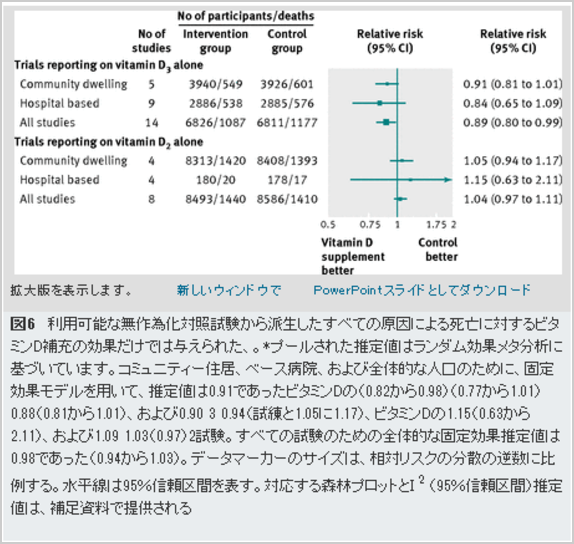
Fig 6 Effects of vitamin D supplementation on all cause mortality when given alone, derived from available randomised control trials. *Pooled estimates are based on random effects meta-analysis. Using fixed effects models, for community dwelling, hospital based, and overall population, the estimates were 0.91 (0.81 to 1.01), 0.88 (0.77 to 1.01), and 0.90 (0.82 to 0.98) for vitamin D3 trials and 1.05 (0.94 to 1.17), 1.15 (0.63 to 2.11), and 1.03 (0.97 to 1.09) for vitamin D2 trials. Overall fixed effect estimate for all trials was 0.98 (0.94 to 1.03). Size of data marker is proportional to inverse of variance of relative risk; horizontal line represents 95% CI. Corresponding forest plots and I2 (95% CI) estimates are provided in supplementary material
私たちは、ビタミンD3全体の異質性の証拠見つからない( eFigure 6aは、異質性のために、Pを= 0.34 )、またはビタミンD 2試験( eFigure 6bは、P異質性= 0.38 ) 。ビタミンD3は、全体的な効果は、場所を越え著しく変化していなかった、性別、人口源、日量、および介入の期間またはフォローアップ( metaregression > 0.05のためのP;図7 ⇓ ) 。
We found no evidence of heterogeneity across vitamin D3 (eFigure 6a; P for heterogeneity=0.34) or vitamin D2 trials (eFigure 6b; P for heterogeneity=0.38). For vitamin D3, the overall effect did not vary significantly across location, sex, population source, daily dose, and duration of intervention or follow-up (P for metaregression>0.05; fig 7⇓).
効果は、しかし、我々は600から2000 IU /日の介入線量を使用したランダム化比較試験での死亡リスクの上昇を観察しているため、ビタミンD2の補充のために重要なのは異なって、短い平均介入期間(
The effects, however, differed importantly for vitamin D2 supplementation, for which we observed an increased risk of mortality in the randomised controlled trials that used an intervention dose of 600 to 2000 IU/day, had shorter average intervention period (
同様に、単変量メタ回帰分析の結果は、ビタミンD3補給のための治療効果との日々の介入の用量または平均介入期間との関連の証拠を示さなかった(それぞれP = 0.47および0.50 ) 。これらは統計的に(それぞれP = 0.06および0.07 、 ) ( eFigure 7 )に有意ではなかったが、証拠は、しかし、日々の介入線量とビタミンD2の補給のための治療効果を持つ平均的な介入期間の関連を示唆した。私たちは、意味のある原因別死亡率の結果に単独でビタミンD補充の効果を結合する十分なデータを持っていた。私たちは(すべてのための> 0.05エッガーの非対称性のために、P )このレビュー( eFigure 8 )に含まれるすべての研究間で出版バイアスの証拠を発見した。
Similarly, results from univariate meta-regression analysis showed no evidence of an association of daily intervention dose or average intervention period with treatment effect for vitamin D3 supplementation (P=0.47 and 0.50, respectively). The evidence did, however, suggest associations of daily intervention dose and average intervention period with the treatment effect for vitamin D2 supplementation, although these were not statistically significant (P=0.06 and 0.07, respectively) (eFigure 7). We had insufficient data to meaningfully combine the effects of vitamin D supplementation alone on cause specific mortality outcomes. We found no evidence of publication bias across all included studies in this review (P for Egger’s asymmetry>0.05 for all) (eFigure 8).
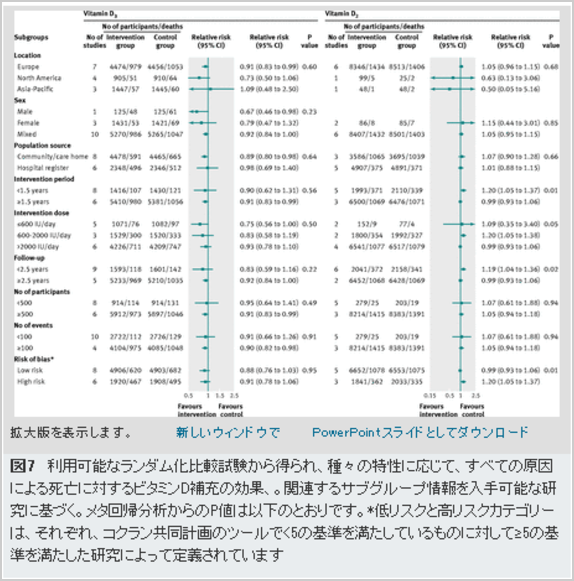
Fig 7 Effects of vitamin D supplementation on all cause mortality, derived from available randomised controlled trials and according to various characteristics. Based on available studies with relevant subgroup information; P values are from meta-regression analyses. *Low risk and high risk categories are defined by studies that met ≥5 criteria versus those that met
ビタミンD欠乏症の有病率と推定絶対リスク
Prevalence of vitamin D deficiency and estimated absolute risk
利用可能なコホートからのデータに基づいて補足的な分析では、ビタミンD不足の有病率は( 25 - ヒドロキシビタミンD濃度
In supplementary analyses, based on data from available cohorts, the prevalence of vitamin D insufficiency (defined as 25-hydroxyvitamin D concentration
さらに、基準は4%と一般人口の15パーセントとして、 25 - ヒドロキシビタミンD濃度未満10 ng / mLのを使用すると、それぞれ、 ( eFigure 9 )欧州と米国の深刻な欠乏だった。さらに、ビタミンD欠乏症に関連付けられているすべての原因による死亡の推定絶対リスク差は、ヨーロッパで75.4イベントや100 000人あたり、米国の96.6イベントであった米国や欧州、 44 45の最新の死亡統計を使用して、あたりの年( eAppendix 5 ) 。この研究から、ビタミンD欠乏の人口有病率の推定値を使用して、ヨーロッパでは全死亡の9.4% 、米国の人々の12.8%がビタミンD欠乏症に起因する可能性がある。
Furthermore, using 25-hydroxyvitamin D concentrations less than 10 ng/mL as the criterion, 4% and 15% of the general population were severely deficient in the Europe and United States, respectively (eFigure 9). Additionally, using the most recent mortality statistics for the United States and Europe,44 45 the estimated absolute risk differences for all cause mortality associated with vitamin D deficiency were 75.4 events in Europe and 96.6 events in the United States, per 100 000 population, per year (eAppendix 5). Using the population prevalence estimates of vitamin D deficiency from this study, 9.4% of all deaths in Europe and 12.8% of those in the United States could be attributed to vitamin D deficiency.
議論 / Discussion
このレビューの結果は、中程度の、しかし重要な、逆の関連がビタミンD濃度と一次予防コホート研究のすべての原因による死亡のリスクを循環する間に存在することを示している。逆相関は、死亡の全ての広範囲の原因に対して、一般的に明らかであった、より具体的に起因する冠動脈疾患、リンパ腫、上部消化癌、および呼吸器疾患による死亡のため。単独で与えられた時に結合されたすべてのランダム化比較試験では、ビタミンD補充は、高齢者の間で、全体的な死亡率を低下させなかった。しかし、サプリメント、ビタミンD3、単独で与えられたの種類によって層別すると、11%の大幅すべての原因による死亡を減少させた。対照的に、単独のビタミンD2の補充は、全体的な死亡率に影響を及ぼさなかった。
The findings of this review indicate that a moderate, but significant, inverse association exists between circulating vitamin D concentrations and the risk of all cause mortality in the primary prevention cohort studies. The inverse association was evident generally for all broad causes of death and more specifically for deaths due to coronary disease, lymphoma, upper digestive cancer, and respiratory disorders. In all randomised controlled trials combined, vitamin D supplementation, when given alone, did not reduce overall mortality significantly among older adults. However, when stratified by type of supplementation, vitamin D3, given singly, reduced all cause mortality significantly by 11%. By contrast, supplementation with vitamin D2 alone had no overall effect on mortality.
調査結果のための可能な説明
Possible explanations for findings
ビタミンDと死亡率との間の逆相関は、いくつかの異なるメカニズムによって説明することができる。先ず、活性型ビタミンDは、主要なことを示す、細胞の成長、増殖、およびアポトーシスおよび免疫系functions.2 8ビタミンD受容体およびその活性化に必要な酵素は、ほとんどのヒト細胞および組織中に存在するに関与する生物学的応答の範囲に影響を与え得る「非骨格」生理的プロセスにおけるビタミンDの役割。第二に、ビタミンD受容体に対して約3000の結合部位は、ヒトゲノム全体にわたって見出されている、ビタミンD受容体への直接的または間接的に応答する(ヒトgenome2の約3%であると推定される)遺伝子の非常に多数の46を示す調節。
The inverse association between vitamin D and mortality can be explained by several different mechanisms. Firstly, activated vitamin D may influence a range of biological responses involved in cellular growth, proliferation, and apoptosis and immune system functions.2 8 Vitamin D receptors and the enzyme required for its activation are present in most human cells and tissues, indicating a major role for vitamin D in “non-skeletal” physiological processes. Secondly, approximately 3000 binding sites for the vitamin D receptor have been found throughout the human genome,46 indicating regulation of a very large number of genes (estimated to be about 3% of the human genome2) either directly or indirectly responsive to vitamin D receptors.
これは、例えば、冠状動脈性心臓病、癌、および死などの低25 - ヒドロキシビタミンD濃度の潜在的な有害な結果と一緒に、 25 - ヒドロキシビタミンDに関連する遺伝的変異を持つ人々に見出さ47は、細胞外カルシウムを超えた内分泌系の重要性を補強するおよびリン酸homeostasis.46第三に、ビタミンD濃度およびより長い白血球テロメアの長さ、年齢関連障害および全体的な寿命の潜在的な決定因子、 48の間に正の関連は、健康な老化と関連するアウトカムに対するビタミンDの可能性のある有益な効果を強調する。
This, along with the potential adverse consequences of low 25-hydroxyvitamin D concentrations, such as coronary heart disease, cancer, and death,47 found in people with 25-hydroxyvitamin D related genetic variants, reinforces the importance of an endocrine system beyond extracellular calcium and phosphate homeostasis.46 Thirdly, the positive association between vitamin D concentrations and longer leucocyte telomere length, a potential determinant of age related disorders and overall longevity,48 emphasises the possible beneficial effects of vitamin D on healthy ageing and associated outcomes.
ビタミンD欠乏症の主な原因は、日光への露出不足、貧しい食生活、増加体脂肪蓄積および減少合成または吸収が含まれるように第四に、 49は貧しいビタミンDの状態は基本的に次善のライフスタイルや社会経済情勢を反映している可能性があります。これらの個々のレベルの要因は、次に、喫煙、血圧、ボディマス指数、およびsupplements.50の使用などの罹患率および死亡率のいくつかの確立された決定因子に対するそれらの潜在的な役割に対する影響リスクは、研究のほとんどは、この口コミ制御に含まれてもよいが彼らはさらに、標準的な社会経済的要因のための調整により層別化した際に、これらの特性のために、そして私たちのプールされた推定値はほぼ横ばいだった、
Fourthly, as primary causes of vitamin D deficiency include insufficient exposure to sunlight, poor diet, increased adiposity, and reduced synthesis or absorption,49 a poor vitamin D status might essentially reflect suboptimal lifestyle and socioeconomic circumstances. These individual level factors may, in turn, influence risk for their potential roles on several established determinants of morbidity and mortality such as smoking, blood pressure, body mass index, and use of supplements.50 Although most of the studies included in this review controlled for these characteristics, and our pooled estimates were largely unchanged when they were further stratified by adjustment for standard socioeconomic factors,
食生活、ライフスタイル、そして社会経済的地位の違いによる可能性の残留や未測定の交絡が懸念残る。このような不明交絡の一部は、以前の最後に他の食事factors.51の観察とインターベンショナル研究の間の観察された調査結果の不一致を説明することができ、我々の研究は、ビタミンDが逆に適度アッパーの冠動脈疾患、リンパ腫、癌による死亡のリスクと関連していることを示している管、および呼吸器疾患の消化器。これらの団体は、将来の大規模な研究では、より良い特性評価を必要としますが、ビタミンD受容体とビタミンDの全身の免疫調節の役割の局所的発現を説明するために提案されているthem.52 53 54 55
potential residual and unmeasured confounding by differences in diet, lifestyle, and socioeconomic status remains a concern. Such unaccounted confounding could partly explain the discrepancy of findings observed earlier between observational and interventional studies of other dietary factors.51 Finally, our study indicates that vitamin D is inversely and moderately associated with risk of death from coronary disease, lymphoma, cancers of the upper digestive tract, and respiratory disease. Although these associations require better characterisation in future larger studies, local expression of vitamin D receptors and systemic immunomodulatory roles of vitamin D have been proposed to explain them.52 53 54 55
サブグループは、すべての原因および癌特異的死亡率と25 - ヒドロキシビタミンD濃度の循環の逆団体は、ビタミンDのサプリメント使用の低い有病率と集団で有意に強いことが示された観察研究の中で分析しています。これは、ビタミンDの効果は、ベースラインのビタミンDの状態に依存し得ることを示唆している。低優勢なビタミンDサプリメントを用いた集団中の25 - ヒドロキシビタミンDの血中濃度のベースラインは、 56低くなる可能性があると死亡率の結果のリスクは、25 - ヒドロキシビタミンDの低い濃度では大きいことが知られている、 27これらのことを考慮調査結果は予想外ではありません。
Subgroup analyses among observational studies indicated that the inverse associations of circulating 25-hydroxyvitamin D concentration with all cause and cancer specific mortality were significantly stronger in the populations with a low prevalence of vitamin D supplement use. This suggests that the effect of vitamin D may be dependent on baseline vitamin D status. Given that baseline circulating 25-hydroxyvitamin D concentrations in a population with low prevalent vitamin D supplement use is likely to be low,56 and that the risk of mortality outcomes is known to be greater at the lower concentrations of 25-hydroxyvitamin D,27 these findings are not unexpected.
さらに、以前の研究はまた、ビタミンD3.57の600 IUの毎日の使用によって達成することができる112ナノモル/ Lまで、 25 - ヒドロキシビタミンD濃度における閾値効果を示唆している、我々は、低いが有意に高い死亡リスクを発見25 - ヒドロキシビタミンDの5年以内のフォローアップを用いた研究中の濃度。これは、因果関係を逆に帰することができる人々は、例えば心血管疾患等の低25 - ヒドロキシビタミンD濃度、に関連する疾患の根底にあるきている。
In addition, a previous study has suggested a threshold effect in 25-hydroxyvitamin D concentrations up to 112 nmol/L, which can be achieved by daily use of 600 IU of vitamin D3.57 Additionally, we found a significantly higher mortality risk of low 25-hydroxyvitamin D concentrations in studies with a follow-up of less than five years. This may be attributed to reverse causality, in which people have underlying diseases that are associated with low 25-hydroxyvitamin D concentrations, such as cardiometabolic diseases.
主に高齢者の中で、単独で与えられたビタミンDサプリメントの利用可能なすべてのランダム化比較試験の我々のメタ分析では、この栄養素が大幅に死亡率の成果を低下させないことを示唆している。しかし、我々は特定のビタミンD代謝物(コレカルシフェロールとして知られている動物由来)、ビタミンD3の形で補充ではなく、ビタミンD2 (エルゴカルシフェロールとして知られているベースのプラント)の影響を考慮したとき、低減死亡率と関連していた。
Our meta-analysis of all available randomised controlled trials of vitamin D supplements, given singly among principally older adults, suggests that this nutrient may not significantly reduce mortality outcomes. However, when we considered the effects of specific vitamin D metabolites, supplementation in the form of vitamin D3 (animal derived, known as cholecalciferol) but not vitamin D2 (plant based, known as ergocalciferol) was associated with reduced mortality.
以前の証拠は、そのように死亡率に対するビタミンD3の期待される効果は大きいかもしれない循環、 58中の25 - ヒドロキシビタミンD濃度を維持する上で、ユニットに対して、潜在的に強力なものとして単位エルゴカルシフェロールを記載した。さらに、以前のレビューは、ビタミンD3と比較してカルシウムのサプリメントの併用の非存在下で、ビタミンD2は、興味深いことに、血清25 - ヒドロキシビタミンDのconcentration.59 60で有意に低かっ全体的な増加とカルシウムとビタミンDの併用を関連していたことを報告ベースライン時に25 - ヒドロキシビタミンDのconcentrations.59のサブグループの下位増加と関連していたことの分析は、ビタミンD2の補給が短い平均介入期間を持っていた試験で死亡率の集計リスクが増加することを示した。
Earlier evidence described ergocalciferol as being potentially less potent, unit for unit, in maintaining 25-hydroxyvitamin D concentrations in the circulation,58 so the expected effect of vitamin D3 on mortality could be greater. Additionally, previous reviews reported that in the absence of concomitant use of calcium supplements, compared with vitamin D3, vitamin D2 was associated with a significantly lower overall increase in serum 25-hydroxyvitamin D concentration.59 60 Interestingly, concomitant use of vitamin D with calcium at baseline was associated with lower increases in 25-hydroxyvitamin D concentrations.59 Subgroup analyses showed that vitamin D2 supplementation increased the aggregate risk of mortality in trials that had shorter average intervention periods.
類似の高いリスクが低い介入用量を使用して試験のために報告された。私たちのメタ分析における矛盾の発見はまた、重要なのは、 (ビタミンD 2試験における平均追跡期間は、D3の試験のためのより少ない年程度であった)、または電力不足によって説明できるこれらの研究におけるサプリメント自身(以外の要因など人口特性の多様性など);そのため、さらにランダム化比較試験は、これらの知見を補強するために必要とされている。
Similar higher risks were reported for trials using lower intervention doses. The discrepant findings in our meta-analysis could also be explained by insufficient power (average follow-up duration in the vitamin D2 trials was about a year less than for D3 trials) or, importantly, factors other than supplements themselves in these studies (such as diversity in population characteristics); therefore, further randomised controlled trials are needed to reinforce these findings.
前作との比較 / Comparison with previous work
この更新されたメタアナリシスの結果は、一般的に同意し、さらにいくつかの重要な点で、以前のレビューを拡張します。まず、本研究では、より詳細に関連付けを検討する力を高めていた。
Findings of this updated meta-analysis generally concur with and further extend the previous reviews in several important ways. Firstly, this study had enhanced power to examine the associations in greater detail.
例えば、一次予防コホート研究の我々のメタアナリシスでは、約10倍の参加者を関与し、このトピックに関する過去のレビューの3倍の死亡率の結果を組み合わせて、 10 19 20〜約10の最近の大規模観察コホート研究が含まれていました。第二に、以前のレビューとは対照的に、我々は、単一の包括的調査の両方の複合、様々な原因別死亡転帰のリスクを定量化するため、使用可能なすべての一次および二次予防コホートの体系的な合成を行っている。
For example, our meta-analysis of the primary prevention cohort studies involved about 10 times as many participants and three times as many mortality outcomes as previous reviews on this topic combined,10 19 20 and included about 10 recent, large scale observational cohort studies. Secondly, in contrast to the earlier reviews, we have done a systematic synthesis of all available primary and secondary prevention cohorts to quantify the risk of both composite and various cause specific death outcomes in a single comprehensive investigation.
第三に、我々は、分析し、極端なビタミンDのベースライン分布の3分の2と、予め指定されたビタミンDのカットオフ値とを比較することによって標準化されたプールされたリスク推定値を提示している。第四に、混合介入、ランダム化比較試験の18 21私たちの最も最新でメタ分析ですべての無作為化試験を含め、以前のレビューとは異なり、単独でビタミンDを投与した排他的に研究が含まれていました。最後に、異質性の潜在的な原因を探求する個人や研究レベルの状況の広い範囲の下で分析を詳述した。それにもかかわらず、私たちの試験のコンポーネントからの調査結果はまたsupplement.18の2形態間の有効性の不均一性を報告した(関係なく、カルシウムとの併用補給のランダム化比較試験に基づく)以前のメタ分析と一致している
Thirdly, we have analysed and presented standardised pooled risk estimates comparing extreme thirds of baseline distribution of vitamin D, and by pre-specified vitamin D cut-offs. Fourthly, unlike previous reviews that included all randomised studies with mixed interventions,18 21 our most up to date meta-analysis of randomised controlled trials included exclusively the studies that administered vitamin D alone. Finally, we did detailed analyses under a broader range of individual and study level circumstances to explore the potential sources of heterogeneity. Nevertheless, the findings from our trial component are consistent with the earlier meta-analysis (based on randomised controlled trials irrespective of concomitant supplementation with calcium) that also reported heterogeneity in efficacy between the two forms of supplement.18
調査結果の含意 / Implications of findings
我々の調査結果はいくつかの意味があるかもしれません。彼らはすべての原因は、低ビタミンDの潜在的に有害な役割を強調し、一次および二次予防コホート内の特定の死亡率の原因となる。さらに、有益な効果は、ランダム化比較試験ではビタミンD3の補給のために認められた。これは、重大な公衆衛生上重要である世界的に報告された25 - ヒドロキシビタミンDの血中濃度が徐々に低下として古い集団、肥満、そして日焼け止めuse.61と組み合わせ、十分な日光曝露の欠如の割合の増加に起因し続ける可能性が高い我々のレビュー、さらにハイライトは、裁判証拠で科学的なギャップを既存の、したがって、例えば、将来research.62を刺激
Our findings may have several implications. They underscore a potentially deleterious role of low vitamin D in all cause and cause specific mortality in both primary and secondary prevention cohorts. Additionally, a beneficial effect was observed for supplementation with vitamin D3 in the randomised controlled trials. This is of significant public health importance, as the gradual decline in circulating 25-hydroxyvitamin D concentrations reported globally is likely to continue owing to the increase in the proportion of older populations, obesity, and lack of adequate sun exposure combined with sunscreen use.61 Our review further highlights existing scientific gaps in the trial evidence and, therefore, stimulates future research.62 For instance,
利用可能な介入研究は一般的に不十分で確実に長期間の使用上の潜在的な毒性作用を調べることができ、最適な投与量をしない評価するために給電され、確実にもっぱら古い参加者を関与含め、コミュニティベースの研究の中で最も低リスクの一般集団における有効性を評価することができませんでした。最後に、病気の他の従来の危険因子による私たちの研究では次善のビタミンDの死亡の推定人口寄与危険度と比較してかなりのようです。たとえば、米国では、約13 %であることによるビタミンD欠乏集団寄与リスクを推定した。
available intervention studies were generally insufficiently powered to reliably assess the optimum dosage, not able to examine potential toxic effects over prolonged use, and unable to reliably assess the efficacy in low risk general populations as most of the included community based studies involved solely older participants. Finally, compared with other conventional risk factors of ill health, the estimated population attributable risk of death due to suboptimal vitamin D in our study seems to be substantial. For example, in the United States, we estimated the population attributable risk due to vitamin D deficiency to be about 13%.
米国では、対応する推定値は、喫煙については約20% 、運動不足のため63約11% 、 64およびアルコールconsumption.65のための約9 %であった。これは世界的に早すぎる死を減らすために、全体的なビタミンD状態の改善に(そのような適度な日光曝露、サプリメント、食品栄養強化など) 、スケーラブルでコスト効果の高い公衆衛生戦略の潜在的な重要性を強調している。
The corresponding estimates in the United States were about 20% for smoking,63 about 11% for physical inactivity,64 and about 9% for alcohol consumption.65. This reinforces the potential importance of scalable, cost effective public health strategies (such as moderate sun exposure, supplementation, and food fortification) in improving the overall vitamin D status to reduce premature deaths worldwide.
長所と研究の限界 / Strengths and limitations of study
我々の調査結果の一般化は、 26カ国ではほぼ900 000の参加者からのデータの関与によって強化されました。我々は、一貫性のある比較を可能にするために標準化された推定値を使用し、広範囲の特性を調べた。
The generalisability of our findings has been enhanced by the involvement of data from almost 900 000 participants in 26 nations. We used standardised estimates to allow consistent comparisons and examined a wide range of characteristics.
しかし、レビューはいくつかの原因別死亡率の結果に利用可能なデータの中程度の量によって制限された。例えば、でも全体として、より少ない1000年、サイト固有のがんによる死亡は、一般的に観察コホート研究で記録された。観測データには、死亡率の結果と観察された関連のか(つまり、原因次善のビタミンDに、ある)直接であるかに限定された明快さを提供する(原因、肥満、身体組成、あるいは社会的地位などの共有の決定に)間接的な。を
However, the review was limited by the moderate amount of available data on several cause specific mortality outcomes. For example, even in aggregate, fewer than 1000 site specific cancer deaths were generally recorded in the observational cohort studies. Observational data also provide limited clarity on whether observed associations with mortality outcomes are direct (that is, due to suboptimal vitamin D) or indirect (due to shared determinants such as obesity, body composition, or social status).
すべて含ま観察研究は、同じ個人で25 - ヒドロキシビタミンD濃度を循環させる連続的評価を欠いていたようにまた、 25 - ヒドロキシビタミンD濃度は、循環中の人物の変動内の任意の範囲の信頼性評価が可能ではなかった。疫学的研究の中で最も特性が誤差の程度を測定し、時間をかけて個人内変動の影響を受けやすいされているため、今後の研究におけるこのような変動の補正は「回帰希釈を避けるために役立つだろう。
Furthermore, as all included observational studies lacked serial assessment of circulating 25-hydroxyvitamin D concentration in the same individuals, reliable assessment of the extent of any within person variability in circulating 25-hydroxyvitamin D concentration was not possible. Because most characteristics of epidemiological studies are measured with a degree of error and are subject to fluctuations within individuals over time, correction of such variability in future studies would help to avoid “regression dilution.
" 66 67の観察研究は介入研究から因果関係、証拠を評価することができないですが、この点で証拠を締結提供することができます。しかし、そのような試験は、一般的にまばらで、主に高齢者を(つまり、原因comorbidities68に死亡の高い競合するリスクが、集団で)含まれており、興味のある主要アウトカムとして、原因特定の死亡オンになっていない典型的に存在するデータを行う。このレビューに含まれている臨床試験の大部分は、バイアスのリスクが低いを持っているようだが、また、我々の調査結果は、特に一次予防のために、それぞれの介入のサブタイプのための試験の数が比較的少ないために、いくつか注意して解釈されるべきである。
”66 67 Although the observational studies are unable to assess the causal association, evidence from the intervention studies could provide concluding evidence in this respect. However, such trials are generally sparse, include chiefly older people (that is, a population with a high competing risk of death due to comorbidities68), and do not typically present data on cause specific deaths as the primary outcomes of interest. Furthermore, although most of the trials included in this review seem to have a low risk of bias, our findings should be interpreted with some caution, owing to the relatively small number of trials for each intervention subtype, especially for primary prevention.
そのため、今回の知見は、このような非白人の民族としての重要なサブグループにおける有効性を定量化する、自由生活の一般的な集団を伴う詳細な今後の介入研究の必要性を強化、適切に給電され、十分に広いを把握することを目指し、適切な投与量と安全性を判断しやすくするために、長期化しているこれまでの無作為化比較試験では従来から行われて、ビタミンD補充のどのフォームを識別するために、ビタミンD2とD3の両方を研究しているよりも、致命的と非致死的な結果の範囲は、最も効率的で安全であることができます。
Therefore, our findings intensify the need for detailed future intervention studies that involve free living general populations, quantify efficacy in important subgroups such as non-white ethnicities, are adequately powered and sufficiently prolonged to help judge appropriate dosage and safety, aim to ascertain a broader range of fatal and non-fatal outcomes than has been customary in the randomised controlled trials thus far, and study both vitamin D2 and D3 to identify which form of vitamin D supplementation can be most efficient and safe.
結論 / Conclusions
観察研究からの証拠は、心血管疾患、癌による死亡、および非血管、がん以外の死因による死亡のリスクに25 - ヒドロキシビタミンD濃度の循環の逆の関連を示している。ビタミンD3の補給は、高齢者の間で、全体的な死亡率を減少させた。しかしながら、任意の広範な補充する前に、さらなる研究は、最適な用量および期間を決定するために、かつ確実にビタミンD3が異なるビタミンD2よりも死亡リスクに影響するかどうかを確立するために必要とされる。
Evidence from observational studies indicates inverse associations of circulating 25-hydroxyvitamin D concentration with risks of death from cardiovascular disease, death from cancer, and non-vascular, non-cancer death. Supplementation with vitamin D3 reduced overall mortality significantly among older adults; however, before any widespread supplementation, further studies will be required to determine the optimal dose and duration and to reliably establish whether vitamin D3 affects the mortality risk differently than vitamin D2.
すでにこのトピックに関する知られているもの
ビタミンDは、全体的な死亡率の結果を含む多くの外性疾患状態に関連付けることができる
What is already known on this topic
Vitamin D may be associated with many extraskeletal disease conditions, including overall mortality outcomes
しかし、さまざまな状況下では、一次および二次予防の設定全体の原因の広い範囲から、死亡のリスクとビタミンD濃度の関連は、あまりよく理解されたまま
However, associations of vitamin D concentrations with risk of death from a broad range of causes, under different circumstances, and across primary and secondary prevention settings, remain less well understood
この研究では、追加されますどのような
観察研究の更新されたメタ分析は、心臓血管疾患、癌、および他の原因による死亡のリスクとビタミンDの血中濃度の逆の関連を示す
What this study adds
Updated meta-analyses of observational studies indicate inverse associations of circulating vitamin D concentrations with risks of deaths from cardiovascular disease, cancer, and other causes
関連するすべてのランダム化された介入研究から合成されたデータだけでは与えられたとき、ビタミンD補充は、高齢者の間で、全体的な死亡率を低下させないことが、ことを示している
Combined data from all relevant randomised intervention studies show that, when given alone, vitamin D supplementation may not reduce overall mortality significantly among older adults
データは単独で、減少し、死亡率が大幅11%与え、補給、ビタミンD3の種類別に層別化した場合には対照的に、ビタミンD2の補充は、単独で死亡率に対する全体的な影響を及ぼさなかった
When data were stratified by type of supplementation, vitamin D3, given singly, reduced mortality significantly by 11% By contrast, supplementation with vitamin D2 alone had no overall effect on mortality
注釈 / Notes
としてこれを引用する: BMJ 2014 ; 348 : g1903
Cite this as: BMJ 2014;348:g1903
脚注 / Footnotes
私たちは、ビタミンDの表形式の情報を私達に助けるため以下の研究の調査官に感謝:リリー·ルイ、ウォーレンブラウナー、ジョーIX、トビアス·ラーション、ヨハンSundstrom 、ヴィンフリートマルツ、マーカスクレベール、ユッカMarniemi 、ナターシャウィーブ、ケア研究調査官、ピーターWilleitを、フランチェスカTentori 、およびKamyar Kalantar -ザデー。
We thank the following study investigators for helping us with tabular information on vitamin D: Lily Lui, Warren Browner, Joe Ix, Tobias Larsson, Johan Sundstrom, Winfried Marz, Marcus Kleber, Jukka Marniemi, Natasha Wiebe, CARE Study Investigators, Peter Willeit, Francesca Tentori, and Kamyar Kalantar-Zadeh.
貢献者: SKは、 AV 、 CO -W 、サウスカロライナ州、およびJCK - DEJは、この作品にも同様に貢献した。 RCとOHFが試験を考案。 SKとRC分析をしました。 RC、 SK 、 CO -W 、サウスカロライナ州、および香港、文献を検索し、データを抽出した。 RCとOHFは原稿を書きました。 JCK - DEJ 、 SKが、 AV、 CPBは、 DP、 MBH 、 BSF 、 AP、 LJ 、 FC、 FBHおよびOHFは原稿の最初の修正に貢献した。 LJは、出版前に原稿の重要な改訂に貢献した。 OHFは保証人である。
Contributors: SK, AV, CO-W, SC, and JCK-deJ contributed equally to this work. RC and OHF conceived the study. SK and RC did the analyses. RC, SK, CO-W, SC, and HK searched the literature and extracted the data. RC and OHF wrote the manuscript. JCK-deJ, SK, AV, CPB, DP, MBH, BSF, AP, LJ, FC, FBH, and OHF contributed to the initial revision of the manuscript. LJ contributed to the critical revision of the manuscript before publication. OHF is the guarantor.
資金調達:なし。 AV、 JCK - DEJ 、およびErasmusAGE 、ネスレニュートリション( Nestec社) 、メタジェニックス社とアクサが出資ライフコース全体で研究を高齢化のための中心にあるOHF作品。ネスレニュートリション( Nestec株式会社) 、メタジェニックス社とアクサは、設計や試験の実施に何の役割を持っていません。収集、管理、分析、およびデータの解釈;または調製、レビュー、または原稿の承認。
Funding: None. AV, JCK-deJ, and OHF work in ErasmusAGE, a centre for aging research across the life course funded by Nestlé Nutrition (Nestec Ltd), Metagenics Inc, and AXA. Nestlé Nutrition (Nestec Ltd), Metagenics Inc, and AXA had no role in design and conduct of the study; collection, management, analysis, and interpretation of the data; or preparation, review, or approval of the manuscript.
利益を競合:すべての著者は、 (対応する著者からのリクエストに応じてご利用いただけます) www.icmje.org / coi_disclosure.pdfでICMJE均一な開示フォームを完了していると宣言していません。提出作業のためのどのような組織からの支援を。前の3年間に提出した仕事に興味を持っている可能性のある団体との金銭的関係ない。なし関係や提出作品に影響を与えているように見える可能性が活動。
Competing interests: All authors have completed the ICMJE uniform disclosure form at www.icmje.org/coi_disclosure.pdf (available on request from the corresponding authors) and declare: no support from any organisation for the submitted work; no financial relationships with any organisations that might have an interest in the submitted work in the previous three years; no other relationships or activities that could appear to have influenced the submitted work.
倫理的承認:必要ありません。
Ethical approval: Not needed.
透明性宣言:執筆者(原稿の保証人)は原稿が報告されている研究の、正直、正確、かつ透明アカウントであることを断言する。研究の重要な側面は全く省略されていないこと;計画通り研究から矛盾が説明されていること。
Transparency declaration: The lead author (the manuscript’s guarantor) affirms that the manuscript is an honest, accurate, and transparent account of the study being reported; that no important aspects of the study have been omitted; and that any discrepancies from the study as planned have been explained.
データ共有:追加のデータ利用できる。
Data sharing: No additional data available.
これは、リミックスを分配適応、非商業的にこの作品に構築し、別の上での二次的著作物のライセンスを他の人を許可するクリエイティブコモンズ非商用( BY- NC 3.0 CC)ライセンスに従って配布さオープンアクセスの記事で用語は、本来の作業が正しく引用し、使用は非商用で提供される。参照: http://creativecommons.org/licenses/by-nc/3.0/ を。...
his is an Open Access article distributed in accordance with the Creative Commons Attribution Non Commercial (CC BY-NC 3.0) license, which permits others to distribute, remix, adapt, build upon this work non-commercially, and license their derivative works on different terms, provided the original work is properly cited and the use is non-commercial. See: http://creativecommons.org/licenses/by-nc/3.0/.
http://www.bmj.com/content/348/bmj.g1903